Don't wanna be here? Send us removal request.
Text
What if I told you there was a way to live out that one hyper specific fantasy you had of mashing up THE BEAR and TRUE BLOOD? And it was a two-player tabletop roleplaying game? And it would be full of flirting, tension, and romance?
Well, guess what? It's happening.
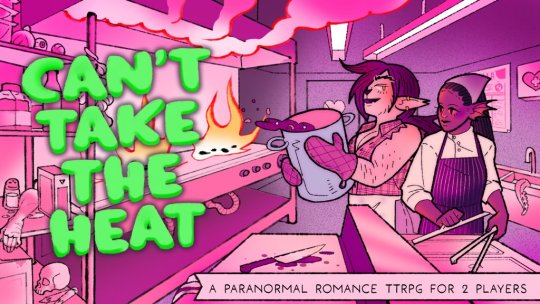
Please follow the KS page so @speedballhippie and I can make CAN'T TAKE THE HEAT:
#indie ttrpg#ttrpg#rpg#roleplaying#tabletop rpgs#ttrpg community#ttrpg art#the bear#true blood#paranormal romance#paranormal
32 notes
·
View notes
Text
Illusory Sensorium ran a game of Barkeep and their writeup is one of the clearest signs that the hard work we put in was worth it.
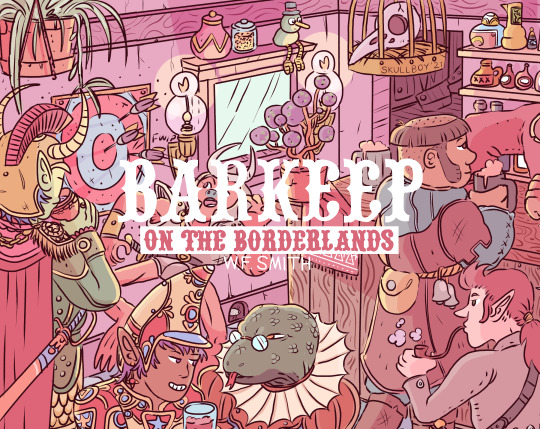
Here's the recap. I genuinely was laughing out loud a few times. Highly recommend: https://illusorysensorium.com/b1-wand-of-embiggening/
If you want to delve into the design theory of Barkeep, keep reading! ⬇️
When we were working on the book, we came up with a sort of mantra for the encounters: Is it sticky? Is it toyetic? Do the NPCs have means, motive, and opportunity? Is there information, choice, and impact?
That's a lot of jargon, and it's been synthesized from across multiple sources. Prismatic Wasteland summed it all up here:
Sticky means that the encounter isn't something the characters can avoid. It sticks to them.
Toyetic came from false machine as well, but also from a post now lost to time from Rebecca Chenier. Basically—will the players and GM want to pick up and play with the encounter?
MMO is just a way to conceptualize NPCs in a simple, understandable form.
ICI is from Bastionland. We can't make informed decisions without information, and there's no point to making decisions if our choices don't matter.
Building the encounters meant looking at each of them carefully and considering those foundational elements. Not EVERY encounter needed every single thing. In fact, with the way WFS wanted to write the book, each encounter had to be relatively short and packing a punch.
A really really sticky encounter didn't need to be as toyetic, and a really fun and interesting encounter that the players would NEED to investigate didn't need to be all that sticky. Everything is a gear of a different size that turns the whole engine.
Illusory Sensorium thinks that they ran the game "wrong" and I disagree. They used the tools provided by the book and had fun! Mission Accomplished!
But one thing they point out very early on is how they "trusted" the encounters in the book as written. The very first one they got is quite simple: 54 skeletons in a conga line, labeled like playing cards.
Incredibly toyetic, not sticky. But the players immediately joined in!
They could have moved on, but that situation was too tantalizing to skip. The rest of the game unfolded from that first encounter, and was filled with shenanigans. The work we put in—hand crafted encounters—worked out!
I'm incredibly proud of the work everyone on the team put into Barkeep, from the writers, artists, and fellow editors. I'm especially proud that people are playing the adventure and having fun. People playing the stuff you've worked on and made is the best feeling as a creator.
Thanks for reading. There's a lot of links in this thread, because I love tracing the history of things. It's no surprise that blogs are the home for so many of these ideas—word of mouth and common practice are easily lost forever when not documented!
The bloggies, a celebration of rpg blogs, are happening now! I've got a post in the running, and I'd love it if you voted for it. My competition is FIERCE (and I recommend all the nominated posts as reading material!)
Vote for RANSACKING THE ROOM today!
#indie ttrpg#ttrpg#gming#rpg#blog#roleplaying#tabletop rpgs#ttrpg community#ttrpg theory#rpg theory#adventure design#adventure
19 notes
·
View notes
Text
THE BLOGGIES 2023: FINALISTS
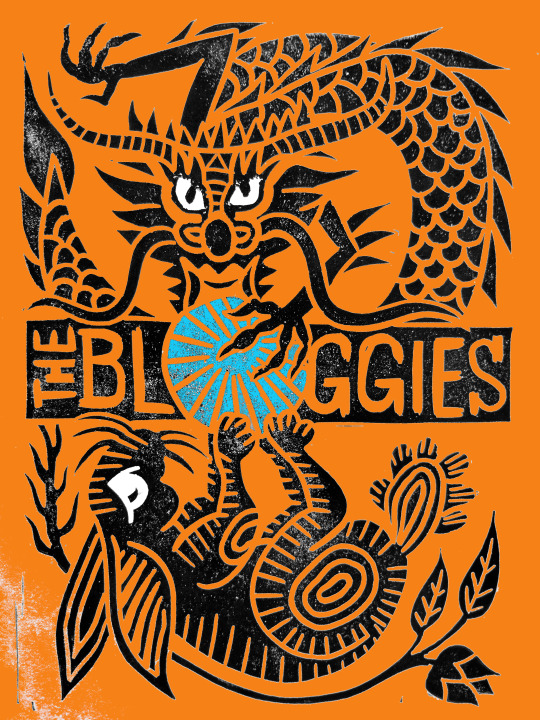
(If you just want to skip to the list of BLOGGIE finalists, scroll to the "Who Are The BLOGGIES?" section below.)
+++
WHAT ARE THE BLOGGIES?
Awards for some of the best tabletop roleplaying game (TTRPG) blog posts to come out in 2022. There will be five awards: Best Theory Blogpost, Best Gameable Blogpost, Best Advice Blogpost, Best Review Blogpost, and, the biggest one, Best Blogpost.
I won Best Blogpost, last year. So I am hosting the BLOGGIES, this year.
+++
WHY ARE THE BLOGGIES?
Blogs are worth celebrating. Barring the actual playing of actual games, they are our most fertile field, our most volatile laboratory. Longform, text-based, and informal---they are a place to jot down our most outre design ideas. Free and publicly available---they are a vector for open debate and serendipitous discourse. Perhaps most importantly: relatively free of algorithmic social-media pressures---they are the best chance we have at a cultural memory.
I got into TTRPGs because of blogs.
The BLOGGIES are, at best, an affirmation of the above. At least, they are a way to celebrate 64 excellent blog posts from the last year, and maybe get them in front of people who did not read them the first time.
+++
HOW ARE THE BLOGGIES?
Nominations: I put an open call for blog-post nominations on Christmas 2023; I also canvassed the TTRPG communities I am part of. Nominated posts had to be from between 1 December 2022 to 31 December 2023.
I closed the nomination period on 1 Jan 2024 with 149 blog posts for consideration. I read / re-read them all.
I chose a slate of 64 finalists, according to the following metrics, in order:
Enthusiasm---a post got multiple nominations;
Diversity---no one blog was allowed to be a finalist more than once in a category (except the Reviews category, where this rule was tied to individual writers, due to shared review blogs);
Notability---a post was extraordinary in presenting a novel idea, addressing an important subject, or reflecting a community current.
Obviously, that last metric is highly subjective, and limited to my knowledge and perspective in the scene. I did my best.
I will not have final final say. Finalists will go head to head, vying for to be anointed best of the best by ballot. The bracket was seeded in order of number of nominations received. The BLOGGIES await your vote, o TTRPG folx.
+++
WHEN ARE THE BLOGGIES?
Throughout January 2024! Voting will happen on Google Forms on the following days (I will link to the forms and result threads as I post them):
First Week January - THEORY
3 January: Round of 16
4 January: Round of 8
5 January: Round of 4
6 January: Quarterfinals (winners in category)
Second Week January - GAMEABLE
10 January: Round of 16
11 January: Round of 8
12 January: Round of 4
13 January: Quarterfinals (winners in category)
Third Week January - ADVICE
17 January: Round of 16
18 January: Round of 8
19 January: Round of 4
20 January: Quarterfinals (winners in category)
Fourth Week January - REVIEW
24 January: Round of 16
25 January: Round of 8
26 January: Round of 4
27 January: Quarterfinals (winners in category)
31 January - FINALS
+++
WHO ARE THE BLOGGIES?
Your BLOGGIES 2023 FINALISTS are (presented in bracket order):

(High-res version here)
+++
THEORY
(1) being a problem - playable orcs at the limits of humanity, from Majestic Fly Whisk Some deep thinking about the racialisation of the orc in elfgames, why mainstream fixes fall short, and ways to move beyond.
vs
(16) #132: Axes of Game Design, from The Indie RPG Newsletter An exploration of the design axes / spectrums on which every TTRPG may fall.
(8) Not All Crunch Is the Same, from A Knight At The Opera An analysis of types of mechanical complexity in games, as a way to argue for complexity's inclusion.
vs
(9) RPG Transcript Analysis: Critical Role, from Trilemma Adventures Examining a style of play through transcript analysis (looking at what is actually being said during a session), with Critical Role as case study.
(5) Critical GLOG: Base Resolution Mechanics, from Goblin Punch A deep dive into dice and resolution mechanics, and what they do in practice.
vs
(12) My favorite problems, from Failure Tolerated A list of design problems in TTRPGs, and a case for game design and theory to be driven by problem-solving.
(4) Roleplay Is Folk Art, from Wizard Thief Fighter An impassioned call to consider TTRPGs as folk art as opposed to corpocratic walled-garden IPs.
vs
(13) ART, PRODUCT, BOARD GAMES AND MAUSRITTER, from Fail Forward Critique of reviews that accuse TTRPGs for being too slick; interrogating the assumptions behind the label “commercial”.
(6) Toolbox Design, from The Dododecahedron Considering the principles of designing TTRPGs like toolboxes, through the lens of Cairn RPG and similar.
vs
(11) Mario vs ActRaiser vs Final Fantasy vs Zelda - Types of Advancement in RPGs, from Rise Up Comus Identifying some general types of advancement in TTRPGs, using videogames as a comparative lens.
(3) Posters, Posers and POSR(s), from Prismatic Wasteland Relitigating whether the OSR is dead, and defining its successor, the Post-OSR.
vs
(14) psychosis is badly written in tabletop games, from paper cult “Attempting to mechanize something so intensely personal, different, and mutable as mental illness is complicated. I think that makes these depictions bad!”
(7) “Rules Elide” and Its Consequences, from Jared Considering the implications of the maxim that "a game is about X when you have rules for everything but X".
vs
(10) Models of High-Level Play, from Benign Brown Beast Loose but useful classifications for types of high-level play: domains; god-like play; etc.
(2) OSR Rules Families, from Traverse Fantasy Sketching the landscape of the OSR, how various systems function, and how their attributes cluster and trend together.
vs
(15) Moralising and manipulation in tabletop roleplaying games, from Playful Void The importance of having design preferences without tying these preferences to moral judgments.
+++
GAMEABLE
(1) Flux Space, from Papers & Pencils A point-crawl procedure specifically designed for labyrinths / dungeons that are architecturally confusing / samey.
vs
(16) Generating Elevation in a Hexcrawl, from Traveler's Rest Procedures and advice on how to generate a mountain-crawl: hiking-focused adventure geography.
(8) The Autumn of Summers, from False Machine God-monsters born of summer, the hunting culture around such beasts, and random tables to generate their attributes.
vs
(9) MIMICS, from Vaults Of Vaarn A spread of novel pretender-creatures, with ecological and social implications.
(5) Another take on demihumans as social constructs, from Cavegirl's Game Stuff What if we consider fantasy races not as separate species, but as differing social roles?
vs
(12) The Apocalypse Archive, from Bearded Devil An unfinished by exemplary #dungeon23 attempt that includes wonderful maps and soundtrack notes.
(4) Pointcrawling Character Creation, from Rise Up Comus A framework for tying character generation to a geography, generating history and familiarity with campaign locales.
vs
(13) how to be erased, from Straits Of Anian Procedures for getting lost and getting led astray, and the kith and spirits one meets in those places.
(6) Dungeon Skirmishing, from All Dead Generations Feature-complete skirmish combat mechanics for OD&D, and the design rationales thereof.
vs
(11) Zelda-Style NPC Personalities, from To Distant Lands A system of generating quick and punchy NPCs, inspired by the way Zelda videogames present NPCs.
(3) GULCH, from Mindstorm A starter town specifically designed for contemporary (horror, urban fantasy, non-fantasy) campaigns.
vs
(14) Down the Road: Local Situation Design, from Deeper In The Game A procedure for quickly generating a powderkeg situation in a local geography of play.
(7) Laws of the Land: meaningful terrain via in-fiction limits and conditions, from Was It Likely? A method to generate meaningful diegetic terrain and tone in an adventuring region.
vs
(10) False Equivalent Exchange, from The Graverobber's Guide A novel magic system, done in natural language, with discussion on how it could be used in play.
(2) Deeper Catacombs, from Benign Brown Beast Iteration notes and a presentation of a comprehensive dungeon tracking procedure.
vs
(15) Inadvisable Decisions (GLΔG), from The Nothic's Eye An evocative alienist character class, based on drawing the attention of alter-describable things from beyond.
+++
ADVICE
(1) How to Handle Parley as an OSR DM, from Goblin Punch Comprehensive notes on to run non-combat encounters without resorting to boring rolls.
vs
(16) GM Pointers: Live-Text Games, from Shadow & Fae Good reminders on how to run live-text games better, so they are better coordinated and don't take forever.
(8) ONLY Roll Initiative, from Bastionland Considerations on how to adjudicate combats, if initiative were the only dice roll in a combat system.
vs
(9) Action Mysteries, from A Knight At The Opera Asserting that good TTRPGs mysteries involve action---not just figuring out the truth but opposing the antagonist's goals.
(5) Modular Ecology, from The Graverobber's Guide A practical approach to including gameable ecology in TTRPGs, by tying materials to specific locations and conditions of the world.
vs
(12) ULTIMATE ANIMIST MECHANIC: EVERYTHING IS A REACTION, from Alone In The Labyrinth How to run a game where all actions are resolved by reaction roll: everything in the world responds by how much they like you.
(4) Game Mastering Like A Park Ranger, from SILVERARM Advice about GM-ing, based on the real-world work experience of being a park ranger.
vs
(13) An OSR approach to Spotlight, from Permanent Cranial Damage The suggestion that intentionally spotlighting characters solves the real-life problem of spotlighting players nicely.
(6) #Dungeon23, from Win Conditions The idea that spawned a thousand notebook dungeons, plus salient advice on how to start / keep going.
vs
(11) The Storyteller Technique, from Possum Creek Games When writing TTRPGs, imagine your game text as a diegetic artefact in the world of the game.
(3) RANSACKING THE ROOM, from Mindstorm A simple and powerful three-step method to handle room-searching in games: inspect, search, and ransack.
vs
(14) Cairn Crash Course, from Widdershins Wanderings A masterclass example on how to write player guides to a game, for Cairn RPG.
(7) AN EXAMPLE OF FKR (NEAR-)DICELESS COMBAT (WITH COSMIC ORRERY!), from Underground Adventures Describing combat in a Free Kriegsspiel Roleplaying (FKR) game, useful in understanding that playstyle.
vs
(10) Re-inventing the Wilderness: Part 1 - Introduction, from sachagoat Figuring out problems with wilderness exploration, and applying a mental-map framework from urban-theory academia.
(2) Dungeon Design, Process and Keys, from All Dead Generations A detailed process to designing and keying a traditional dungeon adventure.
vs
(15) THE D&D IN MY HEAD: In Only 6 Load-Bearing Numbers, from I Cast Light! Identifying the essential and minimum rules you need to remember, to run D&D.
+++
REVIEW
(1) An Empty Africa - PF2E's The Mwangi Expanse and the strange career of Black Atlanticism, from Majestic Fly Whisk A review of Pathfinder’s "The Mwangi Expanse", and a discussion of Black Atlanticism's fraught relationship with its sourcelands.
vs
(16) What Hull Breach Teaches Us, from Mazirian's Garden An assessment of the Mothership RPG third-party "Hull Breach" anthology as a "new standard for anthology companions".
(8) Grave Trespass - Jim Henson's Labyrinth: The Adventure Game, from Bones Of Contention A review of the Labyrinth RPG. It’s got all these things which are "bad" in RPGs, so why does it work?
vs
(9) The First Rumor Tables, Part 2: Caverns of Thracia or Caverns of Quasqueton?, from Tom Van Winkle's Return To Gaming An investigation into the origins of rumour tables in TTRPGs. Did TSR plagiarise Jaquays?
(5) Standing up for D&D's Gen X: 2e (Part 1), from Mythlands Of Erce A full-throated defense of D&D2E, viewing it in the context of its time and as a refinement over 1E.
vs
(12) Systemcrawl: Break!! RPG, from Widdershins Wanderings A review and system analysis of Break!! RPG, which marries JRPG and OSR inspirations.
(4) Dungeon Crawls in Cinema, from Directsun Games Evaluating several films on the basis of how well they function as dungeon crawls.
vs
(13) Reasonable Reviews, from Rise Up Comus A general overview of TTRPG reviews, and what may or may not make them useful.
(6) Deep Dive: A|STATE, from The Indie Game Reading Club A review of a|state, and how it builds on and departs from the Blades In The Dark formula.
vs
(11) I Read Cloud Empress, from Playful Void A review of Cloud Empress, the first descendant of the Mothership RPG ruleset.
(3) Plagiarism in Unconquered (2022), from Traverse Fantasy A forensic analysis of how Unconquered plagiarised Ultraviolet Grasslands and Vaults Of Vaarn.
vs
(14) Rod, Reel, & Fist (Review), from Benign Brown Beast A substantial review of Rod, Reel, & Fist, a "system-forward fishing simulation RPG".
(7) Pedantic Wasteland - Vampire Cruise, from Bones Of Contention A review of Vampire Cruise, a largely system-neutral horror-comedy adventure set at sea.
vs
(10) Dragon Magazine: Player Advice Collection Overview, from Attronarch Athenaeum A comprehensive read-through and rating of 143 Dragon Magazine advice articles.
(2) Spire: The Monstrosity of Empire, the Necessity of Violence, from A A Voigt A comparative-literature analysis of Spire RPG through R F Kuang’s spec-fic novel "Babel, or the Necessity of Violence".
vs
(15) MICROBLOG: CHILDREN'S BOOKS AND TABLETOP GAMES, from Fail Forward Considering the influence of children’s books on TTRPG designers and works like "Barkeep on the Borderlands".
+++
It is difficult to describe how hard it was for me to whittle down the list of nominees to these finalists. I consider each of these 64 a landmark in 2023's TTRPG thinkings, and the folks from which their issue essential reading, going forward. They already deserve a prize.
So here it is, dear bloggers: a hand-carved linocut "finalist's pin" graphic you are free to use on your sites / posts, should you wish:
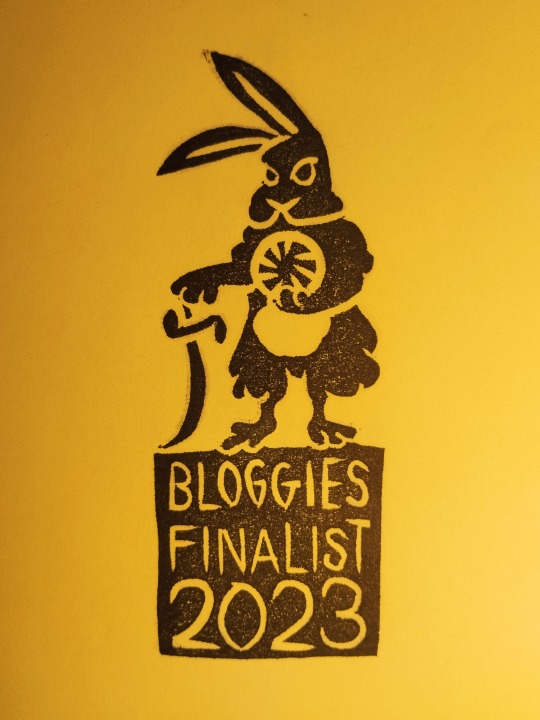
(High-res downloadable version HERE)
Thank you for writing! And good luck in the coming rounds of voting!
182 notes
·
View notes
Text
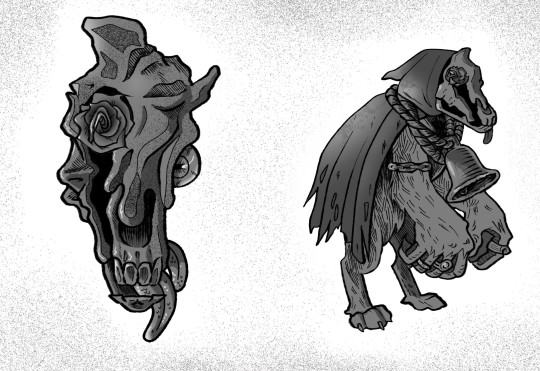
New Mindstorm Blog Post!
A shrill note like a bell rings once in the clear of night. It's bitter hum crescendos into an earth-shattering quake, yet all remains still.
A demon of three notes is a festive stand-alone horror scenario that can be added to any RPG setting.
This scenario contains everything a GM needs to serenade their players with the demon Mirig, an infernal bacchanalian entity who has only one goal: Consume.
He slumbers beneath the village, sending out his bloody offspring—notelings—to infect the people with the deep songs from the pits of hell.
No mere mortal can defeat Mirig. To best the demon, you must use his own magic against him. Sing the notes that no human mouth should ever utter. Three notes to bind him. Three notes to destroy him.
This post was a collaboration between me and @speedballhippie! Norn helped with ideas and design and did the AMAZING art for Mirig and his mask. Give them a follow and reach out for a commission or two: they always deliver a banger.
#indie ttrpg#ttrpg#rpg#blog#ttrpg community#ttrpg art#tabletop rpgs#tabletop roleplaying#roleplaying#gming
16 notes
·
View notes
Text
Bloggie time!!!!
THE BLOGGIES 2023: NOMINATIONS OPEN

If tabletop roleplaying games were a hydra, blogs would definitely be one of its heads.
Probably the smartest, zaniest one? The one with the unexpected ideas; the silliest quips; the most devious schemes; the most profound observations.
The OSR / post-OSR style of play arose on blogs. I was inspired to make roleplaying games because of a blog post (this one, by Patrick Stuart, specifically).
Beyond the actual playing of games with friends, blogs are the most important part of TTRPGs, to me.
+
Last year, Prismatic Wasteland hosted the inaugural Bloggies.

64 excellent posts from across the TTRPG blogosphere were considered. A celebration of our community, our psychic brain-trust---the many heads of this, our TTRPG beast.
All the nominees are worth perusing. Winners list here.
My post, "D&D's Obsession With Taxonomy", won Best Blog Post of 2022. (Thank you, everybody who voted!)
Because I won, it falls to me to host this year's Bloggies.
+
Nominations are now open for the BLOGGIES 2023!
Is there a blogpost about TTRPGs from the past year (December 2022 to December 2023) that you think deserves attention and recognition?
Tell me about it! Drop a link to it, tell me why you like it, tell me which category it falls under:
Theory---broad criticism, observation, and analysis about TTRPGs (its cultures, its aesthetics and texts, its politics, etc);
Gameable---cool stuff (monsters, subsystems, bits of design, etc) you could grab and add to your own games;
Advice---ideas, tricks, and procedures for making your games better / easier / more fun, basically adding to the play-culture;
Review---specific criticism of specific books / games / systems / adventures / products.
Drop your nominations in the comments below, or in this Xwitter thread, or wherever else you can get in touch with me on the Internet. Do this before the end of 31 December 2023.
+
How BLOGGIES 2023 Will Work
Here's how I am thinking of running things:
25 Dec 2023 - 31 Dec 2023: Nominations open!
1 Jan 2024: Nominees shortlist announced!
First week Jan 2024: Public voting for Best Theory Post!
Second week Jan 2024: Public voting for Best Gameable Post!
Third week Jan 2024: Public voting for Best Advice Post!
Fourth week Jan 2024: Public voting for Best Review Post!
First week Feb 2024: Final round of voting for Best Blog Post Of 2023!
"Imperfection is a feature, not a bug, of blogging," as Warren said about the Bloggies, last year. I am but a single person. I will be copying much of his methodology.
I will be whittling down the nominations I receive to a shortlist of 64 posts (16 per category bracket), via personal judgment. No blog will be represented more than once per category---except for reviews (3 posts per blog).
Public voting for each category will happen in four rounds (16 / 8 / 4 / finals). Winners in each category will face off in a four-way vote for Best Blog Post.
Voting will most likely happen on Twitter, same as last year. (I am loathe to do this, but Twitter is still the social-media network most TTRPG people are on, sadly. But am also considering Google Forms. Thoughts?)
Month-long voting gives us the space to celebrate / argue over all the work our community has turned out this year---and gives me time to create prizes. (Am thinking of making linocut prints, inspired by the winning posts.)
Finals being announced in February just before the Lunar New Year justifies the header art above---as the Year of the Rabbit gives way to the Year of the Dragon.
+++
Here we go here we go here we go!
63 notes
·
View notes
Text

🚨 Big news blog-heads!!! 🚨
For 2024 mindstorm is going.... ON TOUR!
I want to crash land on YOUR blog, write a post, and then hit the road again. I'll write anything for you if it's even tangentially related to TTRPGs. I can't promise it'll be good.
Fill out the form below to sign up. If you're reading this and have a blog, you fit the criteria. If you're reading this and don't have a blog, start one now and apply!
https://forms.gle/pcbdyTJxQoRLkHix5
If you don't have a blog but want to help me hit critical mass and get enough applications that I crumble under the pressure, I'd love retweets on this sucker.
1 note
·
View note
Text
Somewhere, anywhere, in North America lies the town of Gulch. This fully made starter town slots easily into horror millieu, urban fantasy, or magicless modern settings. Use it stand-alone or as a pit-stop on a psychedelic roadtrip, compatible with any RPG that has credit cards and cellphones.
First up, a link to the post so you can get right to it: https://www.mindstormpress.com/gulch
Gulch is a collaboration between @speedballhippie and I, with both of us developing ideas for the town, Norn illustrating NPCs, and me slinging words.
All of the Major NPCs, like the eccentric Magpie Merriweather, come with easily adaptable quest hooks and atmospheric locations. This is the beautiful fusion of Americana, Canadiana, and eldritch curiosities.

Gulch is not without tension, however. Two gangs vie for control of the town. On one end the Ivory Owl Radicals think they can build the perfect utopia from horseback. Opposing them are the Midnighters, led by The Ragman, riding their dirt bikes and sowing chaos.

Gulch is a living blog post, with more updates coming soon. Check it out, sign up for the mailing list, and leave comments with your thoughts. We poured everything into this and it really shows.
https://www.mindstormpress.com/gulch
#dnd#osr#gming#adventures#rpg#roleplaying#blog#ttrpg#indie ttrpg#ttrpg community#ttrpg character#ttrpg art
27 notes
·
View notes
Text
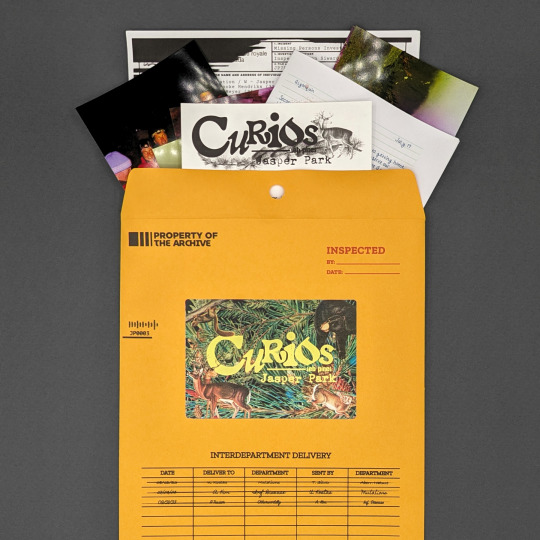
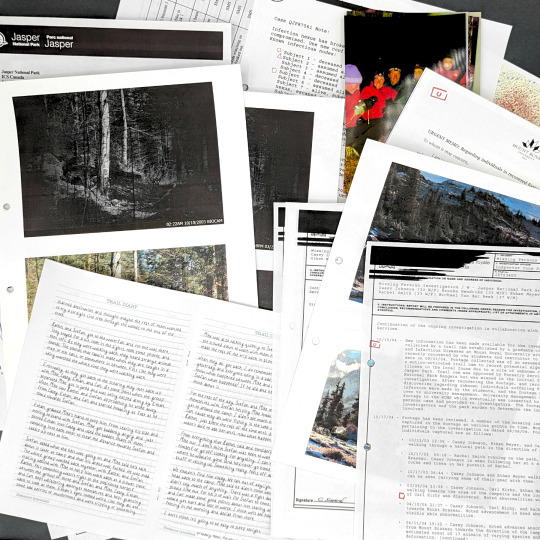
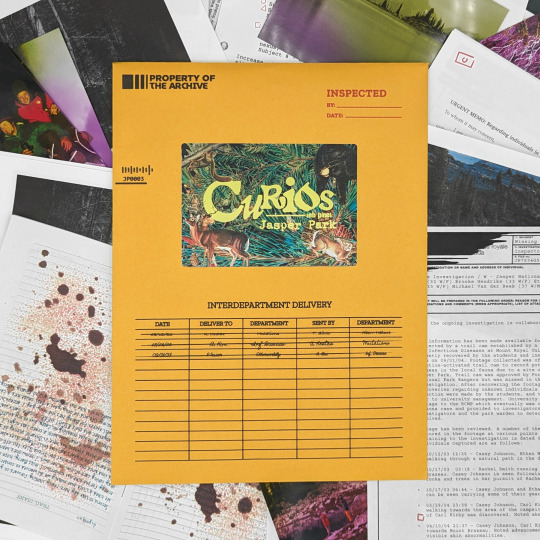
Curios: Jasper Park is an investigative horror mystery experience. An infectious story told over a series of missing persons reports, diary entries, and recovered footage.
The natural world has much to offer us: beauty, challenge, and sometimes danger. For those that foray out into the darkest parts of forests and mountains, some never come back. The search for those that disappear without a trace is long and arduous, especially when the missing don’t want to be found.
Our second collection of elusive events is lost in the trees: The Case of the Jasper Park Disappearances. All that remains of the campers are recovered personal effects and the reports of where they’ve been.
What lurks in the deepest parts of the forest? A group of seven campers in Jasper Park may have learned the answer. A regular backcountry camping trip goes wrong when some of the campers begin acting abnormally. The events that unfold leading up to their disappearance are clouded in mystery. The secrets lie in the recovered evidence left behind at their abandoned campsite. A diary, voicemails, and photos tell a story of a creeping dread surrounding these campers until they all flee their campsite in the middle of the night.
And their disappearance is only the beginning. Reports of disturbances from Jasper Park keep coming in.
85 notes
·
View notes
Text
What can OVER THE GARDEN WALL teach us about creating adventures? A whole lot, it turns out! Let's break down the structure so we can use it for our own designs.
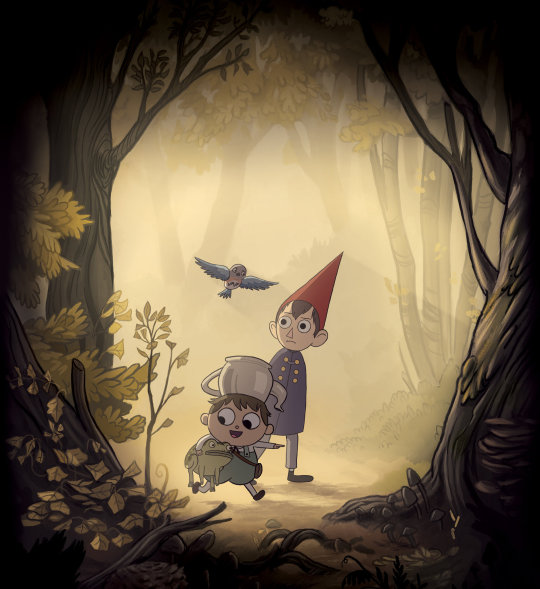
First off, a link to the post:
While the narrative of a television show doesn't translate perfectly to RPGs, each episode of OTGW could be easily reworked to a great adventure.
If we deconstruct them, we end up with four foundational pillars:
A familiar, recognizable situation.
A mystery, question, or strange unexplained circumstance.
A twist on expectations.
A non-reliance on violence.
A FAMILIAR, RECOGNIZABLE SITUATION. If we start with something the players can easily grasp, we can leverage all the baggage and expectations that comes with it to our advantage.
A MYSTERY, QUESTION, OR STRANGE UNEXPLAINED CIRCUMSTANCE. Players are drawn in when there's a known unknown that they can try and solve.
A TWIST ON EXPECTATIONS. This is where you bring your own special sauce to the idea and make it truly yours. Twist the expectations when you're figuring out the answers to the mysteries.
A NON-RELIANCE ON VIOLENCE. Don't conceive of specific solutions to the adventure. But ESPECIALLY avoid violence being the only way to solve the scenario.
The advice here works for all types of adventure, not just for the setting of OTGW or D&D. The post goes into more detail and provides examples. A bonus section talks about how to bring the vibes of OTGW to your game. Check it out!
205 notes
·
View notes